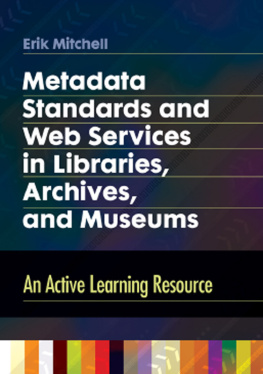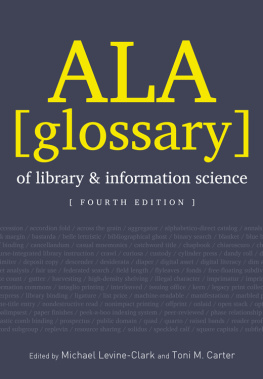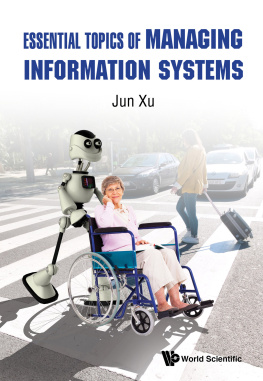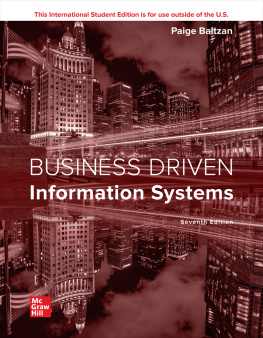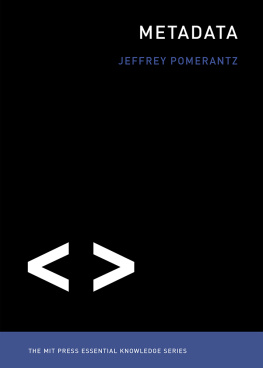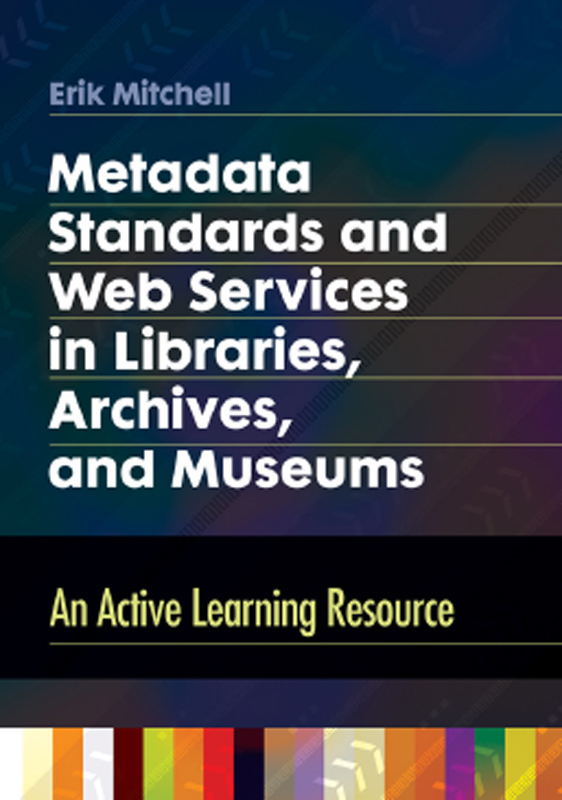Metadata Standards and Web Services in Libraries, Archives, and Museums
Copyright 2015 by Erik Mitchell
All rights reserved. No part of this publication may be reproduced, stored in a retrieval system, or transmitted, in any form or by any means, electronic, mechanical, photocopying, recording, or otherwise, except for the inclusion of brief quotations in a review, without prior permission in writing from the publisher.
Library of Congress Cataloging-in-Publication Data
Mitchell, Erik T., 1972
Metadata standards and Web services in libraries, archives, and museums : an active learning resource / Erik Mitchell.
pages cm
Includes bibliographical references and index.
ISBN 978-1-61069-449-0 (paperback) ISBN 978-1-61069-450-6 (ebook)1. Metadata.2. Information organization.3. Web servicesLibrary applications.4. MuseumsInformation technology.5. ArchivesInformation technology.I. Title.
Z666.7.M58 2015
025.3dc232015015545
ISBN: 978-1-61069-449-0
EISBN: 978-1-61069-450-6
191817161512345
This book is also available on the World Wide Web as an eBook.
Visit www.abc-clio.com for details.
Libraries Unlimited
An Imprint of ABC-CLIO, LLC
ABC-CLIO, LLC
130 Cremona Drive, P.O. Box 1911
Santa Barbara, California 93116-1911
This book is printed on acid-free paper 
Manufactured in the United States of America
CONTENTS

The field of library and information science (LIS) is concerned with the roles, uses, and impact of information in people, across communities and throughout history. Librarianship and other information careers have built a shared understanding of what information is, how it is created and used, and what impact it can have on individuals and communities. In addition, for much of the 20th century, libraries, archives, museums (LAMs) and similar cultural heritage institutions have shared a consistent view of information management, albeit not necessarily consistent systems and standards. Nevertheless, this shared vision has enabled LAM institutions to move quickly into new fields such as information retrieval, information systems analysis, and data curation as the practice of information creation, management, and use changed. Along the way, LAM institutions have had to redefine their information systems to meet shifting technologies and user needs and have had to develop new systems and standards to accommodate digital information resources and networked information communities. To cite a familiar example, library catalogs, initially developed to help users find and gain access to resources, have been re-invented multiple times as information technology changed. Published first on scrolls, later in books, and more recently on catalog cards, in microfiche, and ultimately as web-based applications, library catalogs have sought to provide an important service to library users. In the last decade, however, the needs of information communities have changed as have the formats of the information materials they work with. The development of the Internet into a user-initiated publishing platform and a network of resources turned search engines by Yahoo and Google into world-wide catalogs of information that allowed users to find information in this de facto virtual library created by what is generally called the World Wide Web, or simply the web. The evolution of the web and the information services around it meant that issues that drove the creation of LAM catalogs, such as metadata creation and management, user-focused information needs analysis, and the creation and management of digital documents, became important areas of scholarship and development outside of the LIS domain. It also meant that traditional approaches to description needed to be reconsidered for increasingly complex resources.
The growth of prominence of both information and information technology in our daily lives has also meant that librarians, archivists and other information professionals need to be aware of the digital literacies that support information creation, management, and use. In some cases this means being able to design, build, manage, and facilitate use of digital information tools and resources. Every day we use websites that effortlessly allow us to search, browse, select, and use information. We most likely all have our preferred web search engine that prioritizes results for us and may even show us selected e-mails or file results from our cloud-stored personal documents. The simplicity of these sites masks the complexity underneath them. Designing effective information services involves a complex understanding of user needs, technology tools, document and metadata standards, and modes of information interaction. It means understanding the relationship between web design, information organization, and information technology issues. Underneath each of these services there is a world of technology and information-seeking/interaction theory that guides how we interact with the service as well as allowing us understand what information the service can make available to us. These interactions are supported by information systems that store documents, create and manage representations of these documents for search and retrieval, and provide discovery and interaction methods that make the service usable. Information system designers should design systems by thinking about potential users who have information needs, questions, and abilities that guide their use of the system. Between these systems that store and serve resources and a users information need we have an interaction guided by information-seeking behaviors, humancomputer interactions, and personal information-management practices. Many of these systems and services run on computers that are designed to serve thousands or hundreds of thousands of users at the same time; however, the tools and technologies are not so complex that they cannot run on almost any laptop or desktop computer. These two elements combined, the software and the hardware, could be considered to be an information system.
This book explores the world of information organization from the perspective of digital information service design, seeking ways to understand the shift of information management activities in an expanding universe of digital information. In order to do this it combines technical and conceptual content to help the reader better understand what information organization tasks are and how information systems affect how we use information. The book will focus upon the theories and mechanics of information creation, its use, and reuse in a digital age. The goal is to guide the reader through the domains of information organization, information technology, and information interaction and to explore these domains as the three building blocks of information systems and services. In exploring information system design, this book explores in some detail the connection between metadata and web services, demonstrating how metadata and web services are created, used, and reused.
The simplest definition of metadata, and perhaps the easiest to grasp conceptually, is data about data. Yet, that simple definition fails to reveal what is, in fact, a very complicated and sometimes controversial area of study and practice. Metadata is created every time we add context to information or data, and those who create metadata are often unaware that they are creating it. In the days of the card catalog metadata was something that was created from the title page of a book and captured on a 3x5 card. In our increasingly digital society metadata is generated with every phone call, with every social media post, with every saved document on your computer. The word metadata famously surfaced in 2013 when news of the National Security Agencys collection of information about every phone call made in the United States emerged. It is likely that before the president of the United States gave details about the gathering of metadata for these phone calls people would not have even considered that the simple act of pushing that send button on their mobile phone leaves a record of the number called, the number calling, the duration of the call, and the location where the call was made. Perhaps more importantly, the term

